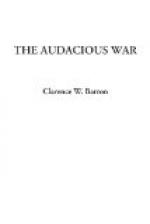As the shadows fall, no guard comes as in England to pull your curtain down according to military orders; and, as you approach Paris, you see families dining by uncurtained windows in blazing light. You are astonished after your London experience of semi-darkness to find the boulevards ablaze and no apparent fear of aerial enemies or sky-invasion, although aeroplanes and Zeppelins and bombs may be flying and fighting only eighty miles away. Now and then a searchlight illumines the heavens, but even searchlights are far less conspicuous than in London. In January the lights were ordered to be lowered; but Paris will not stand for long London fog, gloom, or darkness. The French atmosphere and life demand light.
Paris is gradually getting accustomed to the situation. More than 30 first-class hotels are partially opened and advertising. Many of the business streets have a semi-Sunday appearance. Boulevards running from the Place de l’Opera are well filled with people, and nearly all of the stores are now open. In the first weeks of December you could see the reopening day by day, and when on the 10th the government returned to Paris, the art stores and the jewelry stores joined with the confectioners, trunk dealers, and book-men, and threw open shutters that had been closed four months.
Paris is now normal but not crowded. Theaters are reopening, but the restaurants must be closed at ten P.M. The inhabitants young and old picnic in the Bois de Boulogne and evince most interest in the defences about the Paris gates,—the moats, the new trenches that have been dug, and the tree-trunks that have been thrown down with their branches and tops pointing outward as though to interrupt the progress of an enemy. Buildings have been taken down, and the forts of Paris stand forth as never before; but when you learn how unmanned and how useless they are in modern warfare, you can but smile and join with the people in their curiosity excursions. A single modern shell can put a modern stone-and-steel fort, garrison and guns, entirely out of commission.
A year ago Paris looked dirty and decadent. Her building fronts were grimy, her streets were dirty, and there was a general carelessness where before had been art, precision, and cleanliness. To-day Paris streets are clean. There is even more evidence of rebuilding and of modern conveniences. Motor street-sweepers whirl through the squares, not singly but in pairs and more extended series, and they move with automobile rapidity, quickly cleansing the pavement.
I was reminded thereby of a personal experience at the breaking out of the Spanish-American War. At breakfast on a Sunday morning with one of America’s most successful millionaires, I said, “How is it possible that the stock market can be rising as the country is going to war—a war that may cause some of our new warships to turn turtle and may bring bombardment upon our sea-coast cities? Yet before the guns are booming the stock market is booming. Indeed, the stock market began to boom from the time we declared a state of war.”




